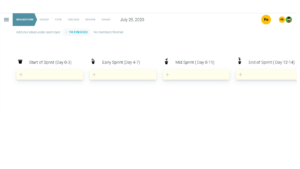
Have you and your agile teams heard of the term recency bias?
Even if you haven’t you might be experiencing it when you conduct your retrospectives without even realising it.
Recency bias is a psychological phenomenon where a person can remember something which has happened to them recently compared to the thing that has happened to them a while back.
Here’s a little test to “experience” recency bias: try to recall the name of the ten or more people that you’ve met in the last week. You will easily tend to remember the names of the people that you’ve met recently compared to the ones that they have reached a long time back right?
So what role does recency bias in retrospectives?
Your feedback is influenced by what happened recently!
If during your sprint you experienced great things at the beginning but nearer the retro time things might have broken down a bit influencing your feedback. This can be detrimental to retros because then you might spend more time going through the “what went less well” rather than “what went well?” and “what do we want to try next?”
OR
If your recent experience was so good that you forget about everything else that you thought “this can be improved for next time,” you might not add anything in the “what went less well” column!
A hotspot for BMWs
Again, when you are focused on your most recent experience, it might result in the impulsiveness to do more BMWs rather than constructive feedback sessions.
How can we mitigate recency bias?
Make retros asynchronous
One way to make sure we mitigate recency bias is to have a place where team members can add things that they want to suggest, bring up or discuss in retrospectives.
Even better would be if it’s something that can be accessed easily while you’re working, be anonymous if you want it to be, and is recorded directly so that you can view it all in one space when it comes to your retro.
In TeamRetro you can create asynchronous retrospectives by creating a retrospective or using one of our templates and then leave the brainstorming page open for team members to add notes whenever they want to during the sprint.

Encourage sharing, anywhere and anytime!
When you have your retro spot available and accessible for team members during any stage for a sprint, you’d need to remind them, remind them again and many more times to use the available retro board.
You can do this via email, or your internal IM platform such as Slack.
Avoid the open box!
Much of the unconscious bias in retros stems from the “open box”.
Retrospectives that lack structure and simply provide teams with a few open-ended questions and a large blank space to fill is breeding ground for recency bias.
One way to add structure to your retro is to create a timeline-based retrospective that looks at getting feedback from the start, midway, and end of sprints. You can create this easily using the custom retro feature and here’s one we prepared earlier.
Look at past retrospectives
By looking at your past retrospective notes and actions lists, you and your team can get a memory to rejig of what happened last time that’s important to follow up on.
Use data to spot the bias
When it comes to the very human problem of bias, analytics is useful!
It can be easy to spot potential bias from the data, like when teams decide on an action from a previous retrospective as essential but in the current situation don’t even mention it as their recent experiences alter previous experiences.
With TeamRetro, features such as voting to decide on priorities and actions that everyone has suggested and agreed upon can then be emailed or shared to Trello, Jira, MS Team, Slack means that everyone can refresh and re-read before upcoming retros.

Try TeamRetro today!
Need to keep recency bias out of your retros? We’d be happy to help with our 30 days free trial and a demo on how our digital tool can help run retros in a coordinated and engaging way.

